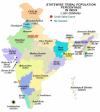A systematic review of population health interventions and Scheduled Tribes in India
- PMID: 20659344
- PMCID: PMC2919477
- DOI: 10.1186/1471-2458-10-438
A systematic review of population health interventions and Scheduled Tribes in India
Abstract
Background: Despite India's recent economic growth, health and human development indicators of Scheduled Tribes (ST) or Adivasi (India's indigenous populations) lag behind national averages. The aim of this review was to identify the public health interventions or components of these interventions that are effective in reducing morbidity or mortality rates and reducing risks of ill health among ST populations in India, in order to inform policy and to identify important research gaps.
Methods: We systematically searched and assessed peer-reviewed literature on evaluations or intervention studies of a population health intervention undertaken with an ST population or in a tribal area, with a population health outcome(s), and involving primary data collection.
Results: The evidence compiled in this review revealed three issues that promote effective public health interventions with STs: (1) to develop and implement interventions that are low-cost, give rapid results and can be easily administered, (2): a multi-pronged approach, and (3): involve ST populations in the intervention.
Conclusion: While there is a growing body of knowledge on the health needs of STs, there is a paucity of data on how we can address these needs. We provide suggestions on how to undertake future population health intervention research with ST populations and offer priority research avenues that will help to address our knowledge gap in this area.
Figures
Similar articles
-
Behavioral interventions to reduce risk for sexual transmission of HIV among men who have sex with men.Cochrane Database Syst Rev. 2008 Jul 16;(3):CD001230. doi: 10.1002/14651858.CD001230.pub2. Cochrane Database Syst Rev. 2008. PMID: 18646068
-
Technological aids for the rehabilitation of memory and executive functioning in children and adolescents with acquired brain injury.Cochrane Database Syst Rev. 2016 Jul 1;7(7):CD011020. doi: 10.1002/14651858.CD011020.pub2. Cochrane Database Syst Rev. 2016. PMID: 27364851 Free PMC article.
-
Mobile phone-based interventions for improving adherence to medication prescribed for the primary prevention of cardiovascular disease in adults.Cochrane Database Syst Rev. 2018 Jun 22;6(6):CD012675. doi: 10.1002/14651858.CD012675.pub2. Cochrane Database Syst Rev. 2018. Update in: Cochrane Database Syst Rev. 2021 Mar 26;3:CD012675. doi: 10.1002/14651858.CD012675.pub3. PMID: 29932455 Free PMC article. Updated.
-
Interventions for promoting habitual exercise in people living with and beyond cancer.Cochrane Database Syst Rev. 2018 Sep 19;9(9):CD010192. doi: 10.1002/14651858.CD010192.pub3. Cochrane Database Syst Rev. 2018. PMID: 30229557 Free PMC article.
-
Interventions targeted at women to encourage the uptake of cervical screening.Cochrane Database Syst Rev. 2021 Sep 6;9(9):CD002834. doi: 10.1002/14651858.CD002834.pub3. Cochrane Database Syst Rev. 2021. PMID: 34694000 Free PMC article.
Cited by
-
A study to assess the occurrence of anaemia and beta-thalassemia in the tribal population residing in the Yadadri-Bhuvanagiri district of Telangana state.J Family Med Prim Care. 2024 Oct;13(10):4611-4615. doi: 10.4103/jfmpc.jfmpc_553_24. Epub 2024 Oct 18. J Family Med Prim Care. 2024. PMID: 39629449 Free PMC article.
-
Tracing the Disparity Between Healthcare Policy-Based Infrastructure and Health Belief-Lead Practices: a Narrative Review on Indigenous Populations of India.J Racial Ethn Health Disparities. 2024 Dec;11(6):3572-3583. doi: 10.1007/s40615-023-01810-3. Epub 2023 Oct 3. J Racial Ethn Health Disparities. 2024. PMID: 37787946 Free PMC article. Review.
-
Exploring biocultural models of chewing tobacco and paan among reproductive-aged women: Self-medication, protection, or gender inequality?Am J Hum Biol. 2019 Sep;31(5):e23281. doi: 10.1002/ajhb.23281. Epub 2019 Jun 21. Am J Hum Biol. 2019. PMID: 31225943 Free PMC article.
-
Determinants of neonatal mortality in rural India, 2007-2008.PeerJ. 2013 May 28;1:e75. doi: 10.7717/peerj.75. Print 2013. PeerJ. 2013. PMID: 23734339 Free PMC article.
-
Examining intentions to take iron supplements to inform a behavioral intervention: The Reduction in Anemia through Normative Innovations (RANI) project.PLoS One. 2021 May 11;16(5):e0249646. doi: 10.1371/journal.pone.0249646. eCollection 2021. PLoS One. 2021. PMID: 33974640 Free PMC article.
References
-
- Sarkar S, Mishra S, Dayal H, Nathan D. Development and deprivation of Scheduled Tribes. Economic and Political Weekly. 2006;18:4824–4827.
-
- India Ministry of Tribal Affairs. The National Tribal Policy: A Policy for the Scheduled Tribes of India. New Delhi: Ministry of Tribal Affairs; 2004.
-
- Xaxa V. Protective discrimination: why Scheduled Tribes lag behind Scheduled Castes. Economic and Political Weekly. 2001. pp. 2765–2772.
Publication types
MeSH terms
Grants and funding
LinkOut - more resources
Full Text Sources
Miscellaneous



